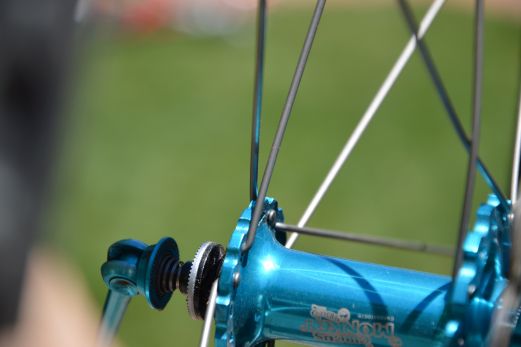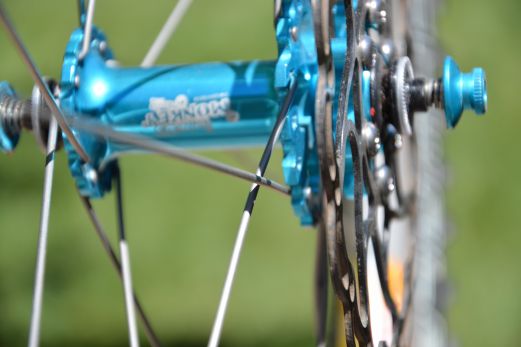Getting the right spoke lengths
One way to avoid the "every second hole" rim drilling problem is to lace the wheel with spokes grouped into pairs that can enter the proper side holes in the rim. This lacing pattern results in two adjacent spoke holes having spokes and then two empty spoke holes.
Calculating the required spoke lengths is a little trickier than the more straight-forward skip every second hole approach. In a nutshell, the paired spoking results in a fractional number of crosses having to be used for the calculation (I used Damon Rinard's Spocalc spreadsheet for all of my spoke length calculations). The trick is, what is that number Fractional Cross number?
If you think about it, the effect of pairing the spokes like I have done in the wheel build above is to move the spokes that cross further apart by one spoke hole. What we need to do is work out what fraction of a normal "cross" that extra skipped spoke hole in the flange will produce.
Here's how to do it:
- decide on the number of spokes you want to use (normally half the number of holes you started with): in my example, 16;work out the angle between the holes of the two spokes that will make up a "pair" (Pair Separation Angle). In my case, with 16 holes/flange this means that each "pair" of holes will be 360/16=22.5 deg apart;
- so we are moving our paired spokes an extra 22.5 deg apart. Now lets work out what a standard 16 hole spoke angle separation (Standard Separation Angle) would be: 360/8=45 deg (we divide by 8 because we're concerned with 8 spokes for one flange);
- now we'll work out the Adjusted Angle = Standard Separation Angle + Pair Separation Angle/2: 56.25 degrees
- Why divide by 2? Because we want the middle of the "pair" to calculate the fractional cross;
- finally, with an Adjusted Angle of 56.5 deg we need to fit 8 of those onto each flange, so the Fractional Cross is worked out as: 56.25deg * 8 / 360deg - 1 = 0.25
Armed with our newly calculated Fractional Cross amount we can figure out what we need to put into our spoke calculator for the number of crosses. For example, the wheel about was built 1x, so the value to put into the spoke calculator is 1.25x . If we were building a 2x wheel, we'd put in 2.25x etc. Just add the Fractional Cross amount to the number of crosses you want.
Note: if you're building something like a 16 spoke spoke wheel you will find it exceedingly difficult to build it 3x. Even 2x can be problematic depending on rim and hub flange diameter.
Lacing the wheel
The only real trick is to get two vacant spoke holes either side of the valve hole (this gives you maximum space around the valve hole for tyre inflation). You do this as follows:
- hold hub so drive side is facing towards you;
- insert key spoke from outside of DS flange;
- put this spoke into the second rim hole clockwise from the valve hole;
- add three more spokes into the DS flange, lacing them every 8 holes from the key spoke;
- flip wheel around sou you are now looking at NDS flange;
- sight along flange and insert spoke from outside of NDS flange into closest anti-clockwise hole from the DS key spoke. This spoke will enter the rim hole that is exactly one hole anti-clockwise from the key spoke;
- repeat NDS outside spoke process for the other 3 spokes;
- flip wheel so looking at DS flange, twist hub anti-clockwise so spokes are pulled tight, insert DS spoke from inside-out into the next clockwise spoke hole from the key spoke, lace this spoke into the rim hole 12 holes clockwise from the key spoke position, repeat for 3 other spokes;
- flip wheel and lace 4 remaining leading spokes on the NDS flange in the same way.
To interlace or not?
When lacing the crossed spokes in the paired pattern, I suggest interlacing them if you can. It is quite possible with certain hub and rim configurations that it is not possible to interlace the spokes. To decide whether to interlace or not, take a look at where the spoke crossing occurs and how far from the hub that occurs. With small diameter flanges, paired 1x lacing can result in the cross being very close to the flange. This can mean that the interlacing is difficult to do and results in radical spoke angles at the flange.

There does not seem to be any conclusive evidence that interlacing produces a stronger wheel. Interlacing will help in keeping the spokes closer in to the center of the wheel, and for this reason its the way to go on the disc side of disc wheels and on the cassette side of rear wheels. Interlacing results in more clearance for disc brake calipers and derailleurs.
